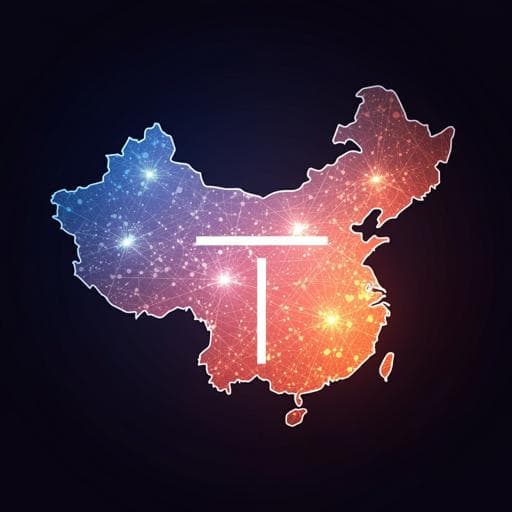
Business
Exploring the spatiotemporal evolution mechanism of rural e-commerce: insights from the experience of Taobao towns in China
X. Cui, W. Huang, et al.
This study explores the fascinating growth of Taobao towns in China through innovative geospatial techniques. Conducted by Xufeng Cui, Wei Huang, Jing Zhang, and Wei Deng, it reveals an expanding coverage and a unique spatial pattern that uncovers key factors driving regional development, including economic and social aspects.
~3 min • Beginner • English
Introduction
China’s e-commerce industry, characterized by low entry barriers and spatial-temporal flexibility, plays an important role in rural revitalization. In policy context (e.g., the 14th Five-Year Plan for E-commerce), e-commerce is positioned as an engine for employment, supply-side reform, and industrial digitalization. Taobao, launched by Alibaba in 2003, began engaging rural development in 2009, giving rise to Taobao villages and later Taobao towns—administrative-economic units highly dependent on platform ecosystems. Taobao villages are defined by thresholds for GMV and active online shops, while Taobao towns (identified since 2014) require at least three Taobao villages or a township-wide GMV ≥ 30 million RMB and ≥ 300 active outlets. Prior research has focused more on the formation, distribution, and effects of Taobao villages, with limited systematic study of Taobao towns’ spatiotemporal patterns and mechanisms. This study addresses the gaps by asking: What stages characterize the transition from Taobao village to Taobao town? What are the global and local spatial characteristics of Taobao towns’ distribution? Which factors drive their development and how do they interact? The purpose is to reveal spatial evolution laws of Taobao towns, clarify driving mechanisms, and inform rural e-commerce upgrading and regional policy.
Literature Review
Early studies on Taobao villages examined formation mechanisms and evolution via case studies and mixed methods, emphasizing government support, talent, logistics, and infrastructure. Research has also explored impacts on rural industrial structure, income, spatial form, entrepreneurship, and social environment, alongside macro- and micro-scale spatial distributions that generally show a coastal-to-inland gradient. Some work notes central/western regions face a “growth-and-disappearance” dilemma. In contrast, Taobao towns have received less attention and are often treated as supplementary to villages, despite being an advanced form with greater administrative attributes, stronger network structures, and higher clustering and transaction scales. Emerging work suggests Taobao towns and villages now follow distinct spatial and developmental logics, with towns representing an upgraded unit in rural e-commerce systems requiring dedicated geographic-spatial analysis.
Methodology
The study synthesizes spatial analysis and spatial-statistical approaches to examine growth stages, spatial distribution, and drivers of Taobao towns in China. Steps: (1) Empirically summarize growth stages of Taobao towns (2014–2021). (2) Apply global spatial autocorrelation (Global Moran’s I) to assess overall spatial dependence, and Getis-Ord General G to distinguish high- vs low-value clustering. (3) Use local spatial autocorrelation (LISA) to map local clusters/outliers (H-H, L-L, L-H, H-L). (4) Employ the standard deviational ellipse (SDE) to capture central tendency, dispersion, anisotropy, and directional evolution across selected years (2015, 2018, 2021). (5) Use GeoDetector to quantify the explanatory power (q-statistic) of driving factors and detect interaction types (e.g., bi-factor enhancement). Data: Counts and locations of Taobao towns (2014–2021) from Ali Research Institute provincial text lists were geocoded to points via Amap; socio-economic variables at the provincial level were compiled and discretized for GeoDetector: X1 GDP, X2 cargo volume, X3 express business volume, X4 road network density, X5 digital village index, X6 number of enterprises with e-commerce activities, X7 regional innovation and entrepreneurship index. Analyses were conducted in ArcGIS for spatial processing and visualization; GeoDetector assessed factor and interaction effects. The methodological choice of GeoDetector avoids linearity assumptions and explicitly handles spatial heterogeneity and autocorrelation better than traditional regressions.
Key Findings
- Growth stages: Three phases identified. (1) 2014–2016 explosive growth: national strategies and supportive policies (inclusive finance, entrepreneurship, talent, logistics, mobile hardware, market regulation) enabled rapid certification and concentration, seeding subsequent growth. (2) 2017–2018 steady growth: shift from quantity to quality amid supply-side reforms, industrial upgrading and place-based specialization; smoother, quality-oriented expansion. (3) 2019–2021 lean development: updated identification criteria emphasized township-wide GMV and active outlets (≥ 30 million RMB and ≥ 300), promoting more mature industrial chains and models and enabling transformation and upgrading.
- Spatial pattern and evolution: Taobao towns exhibit a pronounced “T-shaped and three-center” pattern with a gradient decrease from southeast to northwest; three centers are the Pearl River Delta, Yangtze River Delta, and Bohai Rim urban agglomerations. The central region (e.g., Chengdu–Chongqing, Central Plains Economic Region) shows rapid catch-up and is an emerging center. A pyramid-type size distribution is evident, with many provinces hosting 0–10 towns and very few hosting >100. Initially coastal, the distribution expanded steadily to central and western inland regions by 2018 and subsequently nationwide by 2021. Regions such as Tibet, Inner Mongolia, and Hainan achieved first Taobao towns in 2020 and saw rapid growth in 2021, suggesting potential future high-growth poles.
- Spatial clustering: Global Moran’s I (2021) = 0.453655, Expected = -0.004902, Z = 7.864143, p = 0.000001, indicating significant positive spatial autocorrelation. General G observation = 0.010278 vs expected = 0.003945, Z = 8.502967, p = 0.000001, evidencing high-value clustering. LISA (2021) reveals Low-High outliers (low surrounded by high) expanding since 2018, especially in central and northeastern areas, and Low-Low clusters inland, indicating spatial heterogeneity with strong cores and lagging peripheries.
- Distribution trend (SDE): Centers shifted from 118.53°E, 30.09°N (2015) to 117.58°E, 29.56°N (2018) and to 116.50°E, 31.23°N (2021). Long and short semi-axes increased year by year; rotation angle changed from -170.29° to 4.04°, indicating a prominent north–south, belt-like distribution that broadened and became less anisotropic over time. The center of gravity moved from Hangzhou (Zhejiang) toward Anhui (Huangshan/Lu’an), reflecting expansion beyond the southeast coast and a tilt toward central/western inland areas.
- Drivers (GeoDetector, 2021, provincial level): Express business volume (X3) q = 0.8768, p = 0.000 (strongest); GDP (X1) q = 0.7156, p = 0.000; regional innovation & entrepreneurship index (X7) q = 0.6730, p = 0.000; number of e-commerce enterprises (X6) q = 0.6756, p = 0.0074; digital village index (X5) q = 0.5571, p = 0.0469; cargo volume (X2) q = 0.5384, p = 0.01435; road network density (X4) q = 0.1639, p = 0.4859 (not significant). The results highlight infrastructure for e-commerce logistics, regional economic base, and entrepreneurial climate as key determinants, with market activity and digitalization providing supportive effects. Road network density’s insignificance is attributed to China’s already extensive modern transport network.
- Factor interactions: All pairwise interactions exhibit bi-factor enhancement (q(x1,x2) > max(q1,q2)); no independent or weakening interactions. Notably high combined explanatory powers include X3 with X6 (q ≈ 0.9620), X3 with X4 (≈ 0.9211), and X3 with X5 (≈ 0.9245), underscoring complementarities among logistics capacity, enterprise participation, digitalization, and transport conditions.
- Sectoral and policy context: Express-logistics coverage exceeds 97% of towns/villages (>30,000), reinforcing mutual growth between logistics and rural e-commerce. The central government emphasizes rural logistics and county-level commercial systems, supporting continued robust development.
Discussion
The study clarifies how Taobao towns evolve from village-level nodes into networked agglomerations and why their spatial distribution exhibits multi-core clustering with inland diffusion. Findings address the research questions by delineating distinct growth stages, quantifying global and local clustering, mapping directional shifts, and identifying multi-factor drivers and their synergistic interactions. The results imply that towns—compared to villages—benefit from stronger administrative capacity, scale economies, and network effects, making them better-suited core units for sustaining rural e-commerce under the Internet-era industrial chain integration. The observed inland shift of the development center aligns with broader national strategies (e.g., rise of central China, western development) and suggests future growth poles in central and western regions. Mechanistically, the co-evolution of logistics infrastructure, digitalization, entrepreneurial ecosystems, and economic base underpins expansion and upgrading. Government facilitation (infrastructure, industrial parks, finance, spatial planning) and grassroots initiatives jointly shape outcomes, as evidenced by places like Shaji Town (Jiangsu) and Junpu Village (Guangdong). Strategically, regions with lagging digital village indices and weaker market bases require targeted interventions to convert demonstrated diffusion effects into balanced, inclusive growth while mitigating siphoning effects from high-level clusters.
Conclusion
Taobao towns represent an advanced agglomeration form of rural e-commerce that supports employment, industrial upgrading, and rural revitalization. This study contributes by: (1) identifying a persistent “T-shaped and three-center” spatial pattern, with a southeast-to-northwest attenuation and a pyramid-type size distribution; (2) quantifying key determinants—especially express business volume, GDP, and innovation/entrepreneurship climate—while showing supportive roles for cargo volume, digital village index, and e-commerce-active enterprises, and recognizing transportation as an augmenting, rather than limiting, factor; (3) delineating three temporal stages (2014–2016 explosive; 2017–2018 steady, quality-oriented; 2019–2021 lean, criteria-upgraded), alongside an inland-shifting center of gravity and expanding belt-like distribution. Policy and practice should prioritize strengthening rural logistics and digital infrastructures, fostering entrepreneurship and innovation, and leveraging place-based industrial specialization (e.g., one village/one product; one county/one industry). Future research should deepen micro-level analyses with richer town/village-scale data and fieldwork, examine dynamic interactions within platform ecosystems, and evaluate policies for balanced regional diffusion and resilience.
Limitations
The development of rural e-commerce is still nascent, and there is a shortage of fine-grained statistical data at the village and town scales, limiting analysis of micro-level mechanisms. The study relies on provincial-level indicators for GeoDetector, which may mask intra-provincial heterogeneity. Future work will conduct field research, expand indicator systems, and collect more comprehensive micro-statistics on Taobao towns to better capture causal pathways and enhance practical applicability.
Related Publications
Explore these studies to deepen your understanding of the subject.







